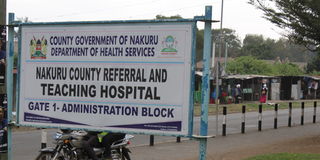Inside PGH's year of highs and lows

Nakuru county referral and Teaching hospital (PGH) is the largest hospital in the South Rift region.
In July and August, Mtaa Wangu visited Nakuru Level 5 Provincial General Hospital (PGH) to investigate the slow and often frustrating processes patients experience at the facility.
The reporter's own experience was a vivid example of these challenges: a 30-minute wait just to receive a consultation receipt at the billing desk. For someone who is already unwell, such delays can feel like an eternity.
The Nakuru Level 5 PGH, which serves not only Nakuru County but also its eleven sub-counties and neighboring regions, is a critical healthcare provider.
However, the hospital faces significant challenges in patient management and service delivery. These problems affect the overall patient experience, particularly in terms of efficiency and timeliness.
During the visit, Mtaa Wangu also highlighted the case of the late 72-year-old Peter Mbugua, who was diagnosed with tuberculosis (TB). His son, David Njuguna, recounted how his father's death was exacerbated by delays in service delivery.
Despite arriving early at 6 a.m. and initially seeing a doctor, the family was forced to wait another 40 minutes just to complete the billing process.
This delay was mitigated somewhat by the help of family members, but it highlights a troubling trend in the hospital's operations.
The slow pace of service at the hospital has been exacerbated by problems with the new Social Health Access (SHA) health insurance system.
Patients have reported significant frustration with the system, which contributes to the overall difficulty of getting timely medical care.
For example, Simon Ngure, who broke his right leg and later developed a cyst on his left leg, shared his experience with the hospital. Ngure, who had a current National Health Insurance Fund (NHIF) card, still had to pay out-of-pocket for services.
Ngure's experience also highlighted problems with the hospital's queuing system, which is designed to manage patient flow in a manner similar to banks. Unfortunately, many of the queuing machines were broken, making the system largely ineffective.
"As long as someone knows a staff member, whether it's a white coat or even a janitor, they can skip the line," Ngure explained.
This practice leaves many patients frustrated as they wait for long periods of time. For those without connections within the hospital, navigating the process becomes a daunting task.
The hospital had previously used a numbering system to help regulate queues, but that system is no longer operational. A spot check by Mtaa Wangu confirmed that the queuing machines were indeed broken and disconnected.
As a result, queues are now determined by where people sit in the waiting area, contributing to further disorganization.
Ngure also raised concerns about the hospital's emergency department, where individuals posing as "lawyers" have begun targeting accident victims.
These individuals, often referred to as "ambulance chasers," swoop in on patients before they receive medical treatment and attempt to offer legal services for injury claims.
"There was no such thing before," Ngure said. "It was up to the patient to recover and start the due process for compensation. But now these people come in before the patient has been treated, making the process more stressful and complicated."
In response to these issues, the hospital's medical director, Dr James Waweru, explained that the "lawyers" are often ambulance chasers, acting on behalf of lawyers looking for clients to sue for damages. While the hospital attempts to control their access, these individuals are difficult to identify as they do not have any identification.
Dr. Waweru assured that despite their disruptive presence, these people do not interfere with patient care.
Regarding the issue of line-jumping, Dr Waweru acknowledged that the problem was likely caused by employees of the previous security company. He said the hospital is taking steps to address the issue by changing its security team.
In addition, the facility is working to implement a new Health Management Information System (HMIS) and queue management software. This new system, which is expected to be fully operational by the end of March 2025, aims to digitize the queue process and streamline patient flow.
In response to reports of uniformed staff attending to patients, Dr. Waweru asserted that he had not personally encountered such instances and stressed that any such incidents would be investigated and addressed.
Although County Executive Committee member Roselyn Mungai has stated that the department is looking to reduce expenditure, it is clear that significant improvements are needed in basic services and patient experience at Nakuru Level 5 PGH.
Addressing these issues should be a priority, not only for the sake of efficiency, but also for the well-being and dignity of the patients who rely on the hospital for care. It is hoped that with the planned changes, the facility will be able to provide a more efficient and patient-friendly environment in the near future.


